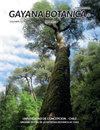松果Isodon rugosus (Lamiaceae)成熟酶- k基因的分子特征
IF 0.5
4区 生物学
Q4 PLANT SCIENCES
引用次数: 0
摘要
摘要trn/mat-K基因的分子标记是解决药用植物分类学和条形码问题的重要候选标记之一。首次鉴定了rugosus (Lamiaceae)中trn/mat-K基因的特征(NCBI GenBank登录号:MH939199.1)。用通用引物matK472F和matK1248R扩增出全长756 bp的序列。据报道含有trnK基因(>1.....50;>746.....756),部分序列;和matK基因(>51.....745),部分编码DNA序列。比对和分析表明,目前只有9种不同的Isodon种可用于GenBank中提交的重复副本的matK序列。据报道,该物种的matK序列为34.2 (G + C)%,有17个可变位点(VS),其中7个位点为单位点(ST), 10个位点为种特异性的简约信息位点(PI),可用于区分其他物种和鉴定分类群。系统发育分析结果表明,在最大似然(ML)和最大简约(MP)方法下,熊蠓的单系聚类接近有狼蠓的支系。与MP树相比,ML树中获得的进化枝信息更丰富。本文章由计算机程序翻译,如有差异,请以英文原文为准。
Molecular Autograph of Maturase-K Gene in Isodon rugosus (Lamiaceae)
Abstract Molecular autograph of trn/mat-K gene was used as one of the important candidate marker in addressing the questions of systematics and barcoding of medicinal plants. Features of trn/mat-K gene in Isodon rugosus (Lamiaceae) were assessed for the first time (NCBI GenBank Accession Number: MH939199.1). Sequence of 756 bp length was amplified by the universal matK primers (matK472F and matK1248R) in the cpDNA of the plant. It was reported to contain trnK gene (>1…..50; >746…..756), partial sequence; and matK gene (>51…..745), partial coding DNA sequence. Alignment search and analysis showed that only nine different Isodon species are currently available for matK sequences with repeated copy of submissions in GenBank. The matK sequences of I. rugosus was reported with 34.2 (G + C)% and 17 variable sites (VS), out of which seven were singleton (ST) and 10 sites were species-specific parsimoniously-informative (PI) that could be used to differentiate I. rugosus from other species as well as to authenticate the taxon. Phylogenetic analysis resulted into monophyletic clustering of I. rugosus near to the clade having I. coetsa by both maximum likelihood (ML) and maximum parsimony (MP) methods. Clades obtained in ML tree were more informative as compared to MP tree.
求助全文
通过发布文献求助,成功后即可免费获取论文全文。
去求助
来源期刊

GAYANA BOTANICA
Agricultural and Biological Sciences-Plant Science
CiteScore
0.70
自引率
0.00%
发文量
8
审稿时长
6-12 weeks
期刊介绍:
The journal welcomes works carried out by scientists of all nationalities, and may be written in either English or Spanish. The journal receives works in systematic, taxonomy, floristic, ecology, physiology, morphology, development, conservation, cytology and phytochemical botany.
 求助内容:
求助内容: 应助结果提醒方式:
应助结果提醒方式:


